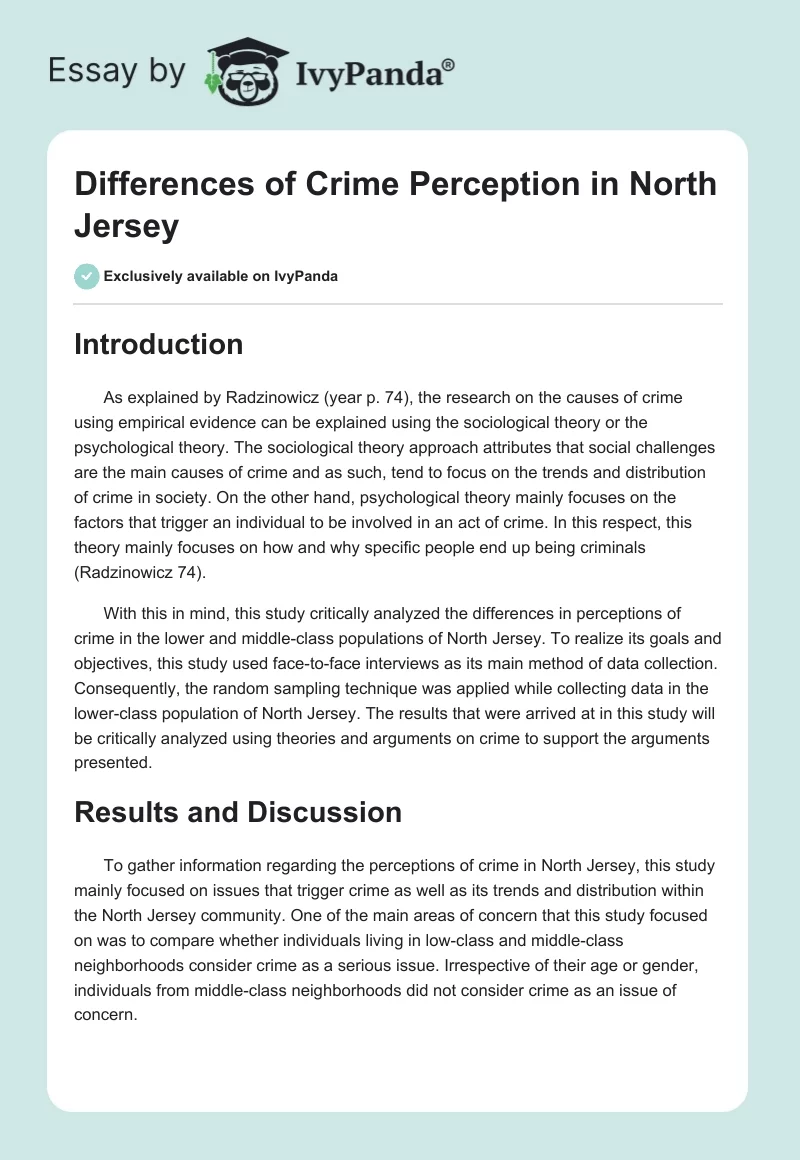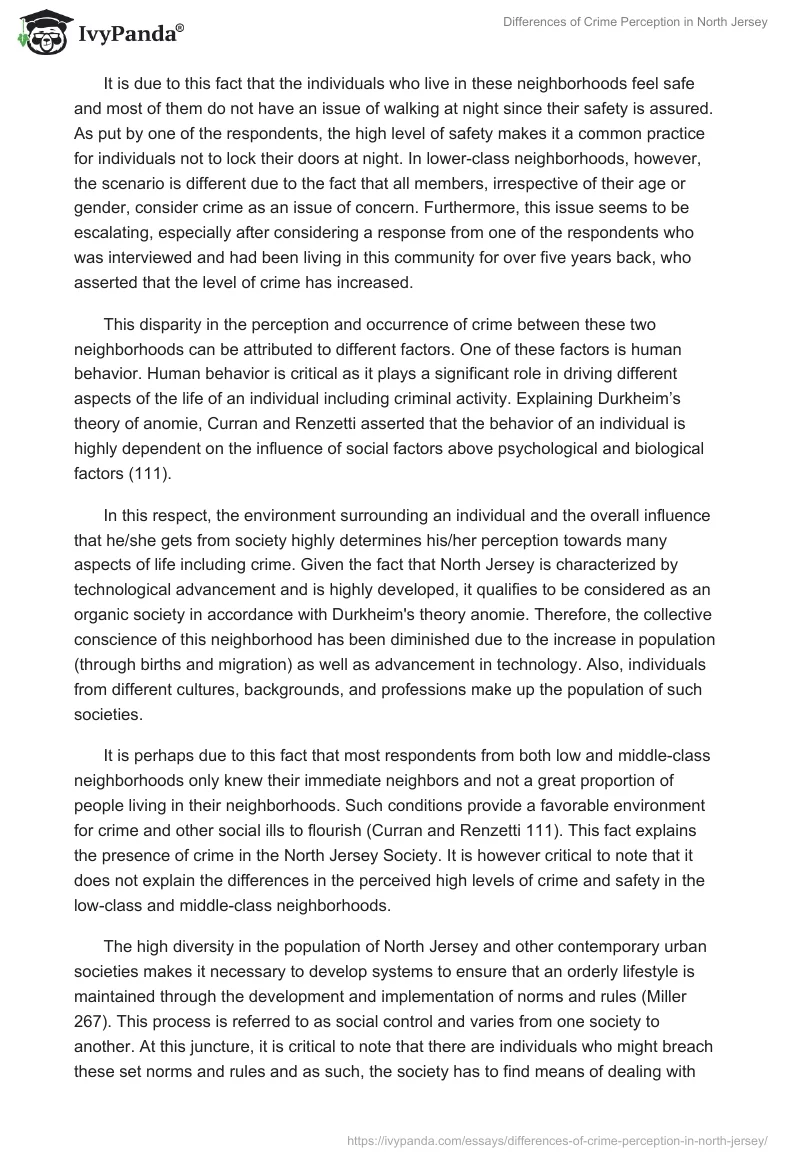Introduction
As explained by Radzinowicz (year p. 74), the research on the causes of crime using empirical evidence can be explained using the sociological theory or the psychological theory. The sociological theory approach attributes that social challenges are the main causes of crime and as such, tend to focus on the trends and distribution of crime in society. On the other hand, psychological theory mainly focuses on the factors that trigger an individual to be involved in an act of crime. In this respect, this theory mainly focuses on how and why specific people end up being criminals (Radzinowicz 74).
With this in mind, this study critically analyzed the differences in perceptions of crime in the lower and middle-class populations of North Jersey. To realize its goals and objectives, this study used face-to-face interviews as its main method of data collection. Consequently, the random sampling technique was applied while collecting data in the lower-class population of North Jersey. The results that were arrived at in this study will be critically analyzed using theories and arguments on crime to support the arguments presented.
Results and Discussion
To gather information regarding the perceptions of crime in North Jersey, this study mainly focused on issues that trigger crime as well as its trends and distribution within the North Jersey community. One of the main areas of concern that this study focused on was to compare whether individuals living in low-class and middle-class neighborhoods consider crime as a serious issue. Irrespective of their age or gender, individuals from middle-class neighborhoods did not consider crime as an issue of concern.
It is due to this fact that the individuals who live in these neighborhoods feel safe and most of them do not have an issue of walking at night since their safety is assured. As put by one of the respondents, the high level of safety makes it a common practice for individuals not to lock their doors at night. In lower-class neighborhoods, however, the scenario is different due to the fact that all members, irrespective of their age or gender, consider crime as an issue of concern. Furthermore, this issue seems to be escalating, especially after considering a response from one of the respondents who was interviewed and had been living in this community for over five years back, who asserted that the level of crime has increased.
This disparity in the perception and occurrence of crime between these two neighborhoods can be attributed to different factors. One of these factors is human behavior. Human behavior is critical as it plays a significant role in driving different aspects of the life of an individual including criminal activity. Explaining Durkheim’s theory of anomie, Curran and Renzetti asserted that the behavior of an individual is highly dependent on the influence of social factors above psychological and biological factors (111).
In this respect, the environment surrounding an individual and the overall influence that he/she gets from society highly determines his/her perception towards many aspects of life including crime. Given the fact that North Jersey is characterized by technological advancement and is highly developed, it qualifies to be considered as an organic society in accordance with Durkheim’s theory anomie. Therefore, the collective conscience of this neighborhood has been diminished due to the increase in population (through births and migration) as well as advancement in technology. Also, individuals from different cultures, backgrounds, and professions make up the population of such societies.
It is perhaps due to this fact that most respondents from both low and middle-class neighborhoods only knew their immediate neighbors and not a great proportion of people living in their neighborhoods. Such conditions provide a favorable environment for crime and other social ills to flourish (Curran and Renzetti 111). This fact explains the presence of crime in the North Jersey Society. It is however critical to note that it does not explain the differences in the perceived high levels of crime and safety in the low-class and middle-class neighborhoods.
The high diversity in the population of North Jersey and other contemporary urban societies makes it necessary to develop systems to ensure that an orderly lifestyle is maintained through the development and implementation of norms and rules (Miller 267). This process is referred to as social control and varies from one society to another. At this juncture, it is critical to note that there are individuals who might breach these set norms and rules and as such, the society has to find means of dealing with these types of breaches. In North Jersey, Crime is a breach of law and is punishable. However, from the results, the instances of crime in middle-class neighborhoods are lower as compared to low-class neighborhoods. This difference can be attributed to the difference in the culture among the individuals living in these neighborhoods.
In accordance with the social disorganization theory, social factors such as lack of proper jobs, poverty, lack of proper education, poor living standards, and so on have greatly contributed to the high levels of crime in low-income neighborhoods such as the ones in North Jersey (Warner 75). These motivators of crime tend to weaken the overall culture of the society and its ability to suppress crime and other social ills.
However, middle and high-class societies tend to highly articulate norms and laws due to reduced social pressure since they have access to good jobs, education, proper housing and healthcare, and so on. Given these two disparities, it is evident that more individuals from low-class neighborhoods will tend to result to crime as a means of meeting their social needs as compared to individuals from middle-class neighborhoods, hence explaining the differences in the level of crimes between them. This claim is consistent with the respondents’ perception of the reasons why individuals engage in crime as an act of necessity to meet their social needs and obligations.
This explains the reason why most of the respondents from both low and middle-class neighborhoods have been victims of crime. In middle-class neighborhoods, more females were victims of crime as compared to males. In lower-class neighborhoods, on the other hand, both men and women were equally attacked. Additionally, the results also showed that the elderly members of both neighborhoods stood a high chance of being victims of crime.
Conclusion
From the results of this study and the discussion presented, it is evident that crime is present in both low-class and middle-class neighborhoods, across gender as well as age groups. Additionally, this study has also shown that the level of crime is higher in low-class neighborhoods as compared to middle-class neighborhoods due to the fact that social organization and culture is stronger in the latter as compared to the former. Consequently, individuals from low-class neighborhoods tend to engage in crime as an act of necessity to meet their social needs.
Despite all this, individuals from both neighborhoods, irrespective of their gender or age, stand a chance of being victims of crime. Therefore, measures need to be put in place to reduce the high levels of crime in low-class neighborhoods, hence guaranteeing the safety of all members of the North Jersey society.
Works Cited
Curran, Daniel and Claire Renzetti. Theories of Crime, New York: Allyn and Baccon, 2001. Print.
Warner, Barbra. “The Role of Attenuated Culture in Social Disorganization Theory.” Criminilogy, 41.1 (2003): 73-98. Print.


